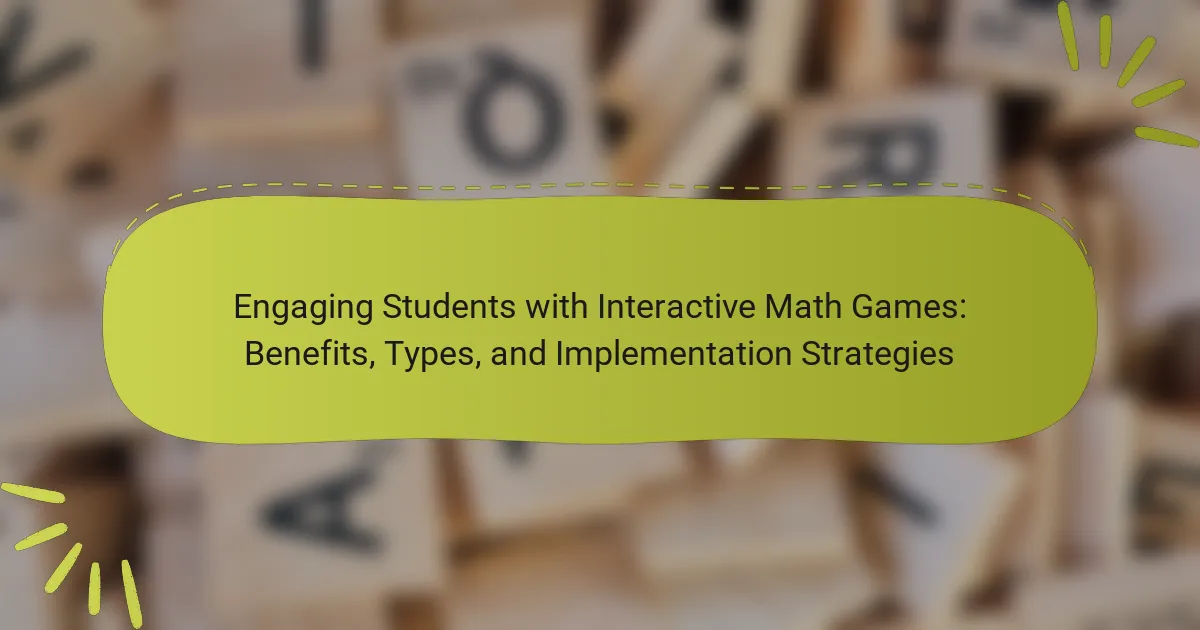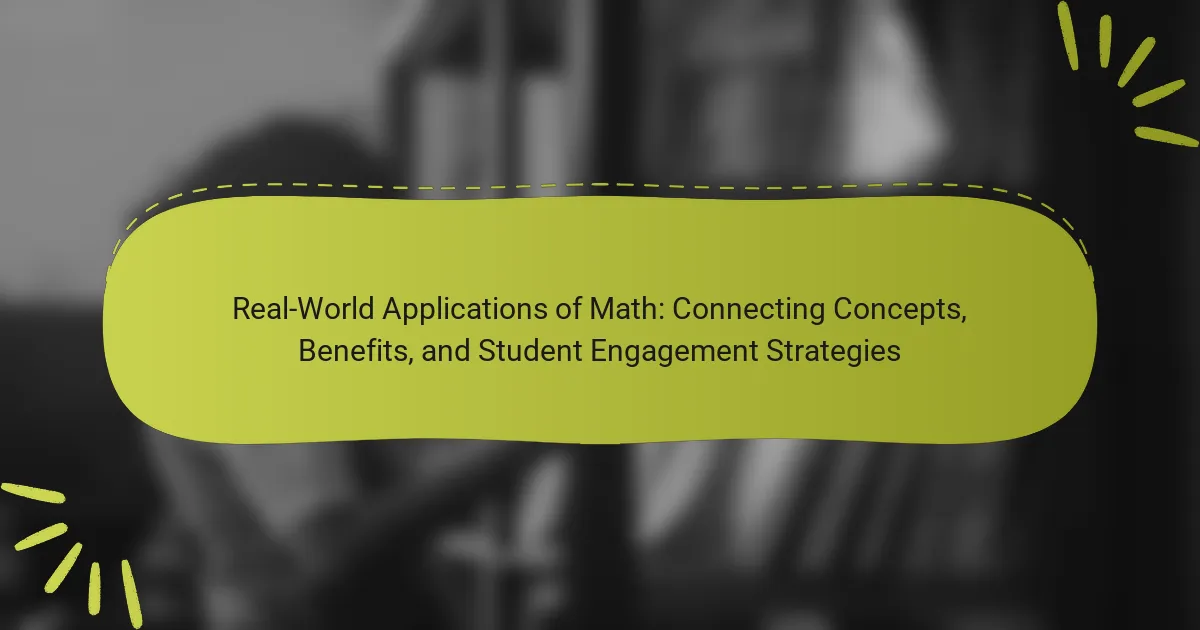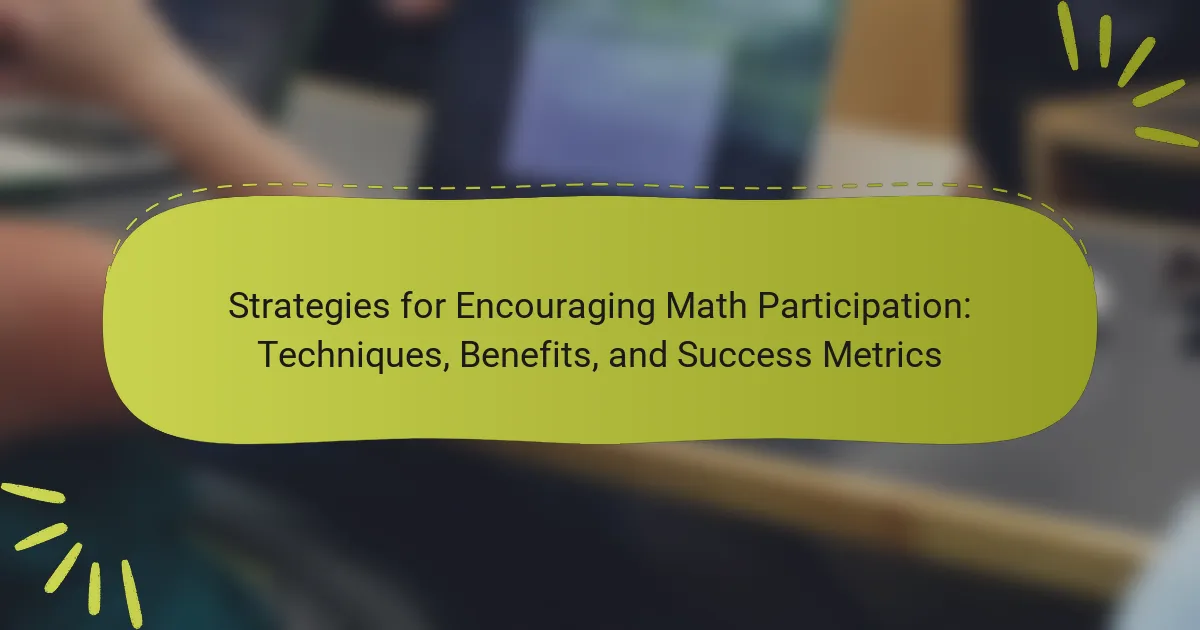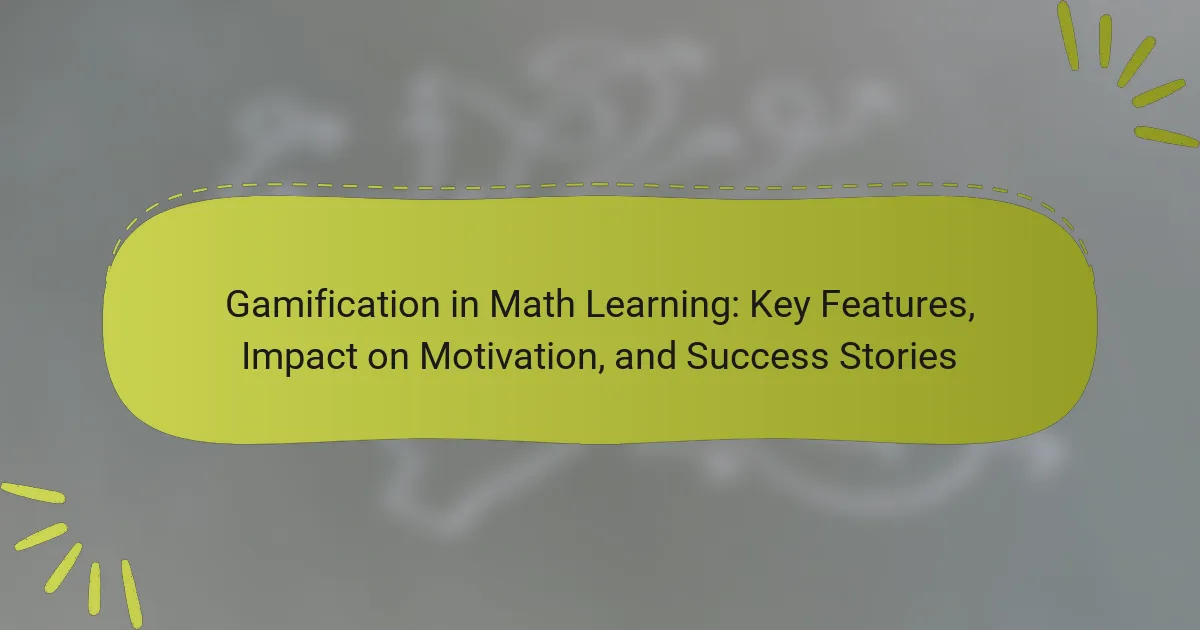Storytelling in math lessons is a pedagogical approach that enhances student engagement and comprehension by linking mathematical concepts to real-life scenarios. This method fosters a deeper understanding of abstract ideas and encourages critical thinking and problem-solving skills. Research indicates that narrative-based learning improves retention of mathematical concepts and creates a collaborative classroom environment, where students are more likely to participate. Techniques such as using narrative scenarios, visual aids, and role-playing activities are effective in implementing storytelling in math education, ultimately leading to improved learning outcomes and increased student motivation.
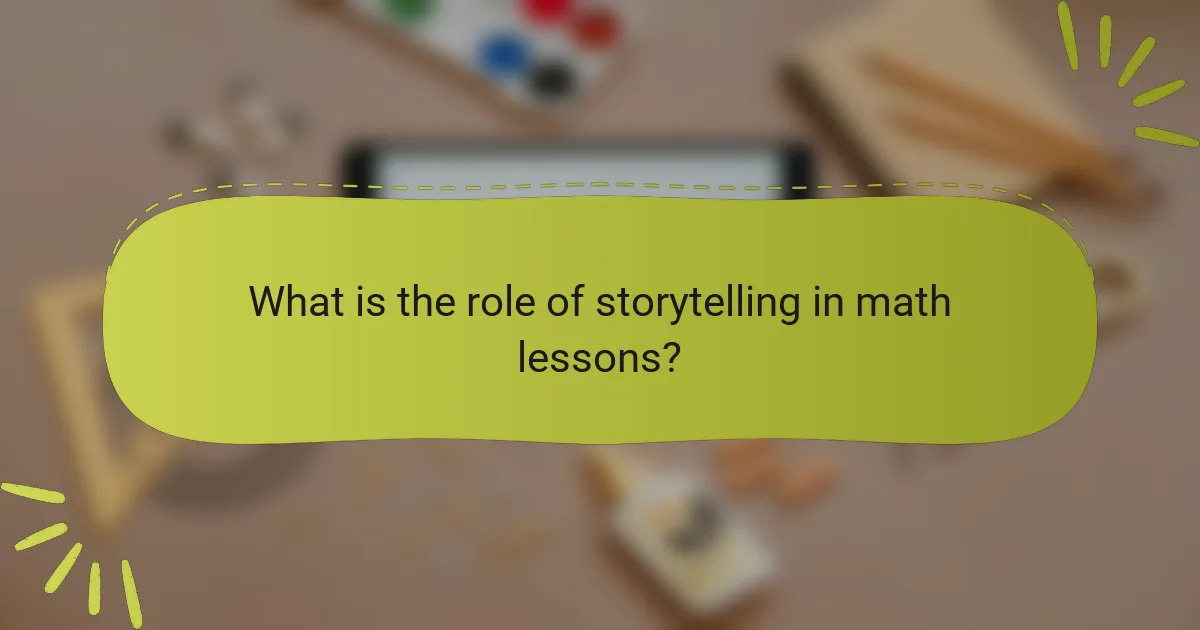
What is the role of storytelling in math lessons?
Storytelling in math lessons enhances student engagement and comprehension. It connects mathematical concepts to real-life scenarios. This approach fosters a deeper understanding of abstract ideas. Storytelling also encourages critical thinking and problem-solving skills. Research shows that narrative-based learning improves retention of mathematical concepts. Additionally, it creates a collaborative classroom environment. Students are more likely to participate when lessons are relatable. Overall, storytelling serves as a powerful tool in math education.
How can storytelling enhance mathematical understanding?
Storytelling can enhance mathematical understanding by providing context and relevance to abstract concepts. It allows students to visualize problems and see real-world applications. For instance, a story involving characters facing mathematical challenges can make concepts like fractions or geometry relatable. Research indicates that narrative techniques improve retention of mathematical ideas. A study by the National Council of Teachers of Mathematics found that students engaged in storytelling performed better in problem-solving tasks. Storytelling fosters emotional connections, which can lead to deeper comprehension and engagement in mathematics.
What types of stories are most effective in teaching math concepts?
Narrative stories that incorporate real-life scenarios are most effective in teaching math concepts. These stories provide context and relevance, making abstract concepts more tangible. For example, using a story about shopping can illustrate addition and subtraction through relatable experiences. Research indicates that contextual learning enhances retention and understanding. Furthermore, character-driven narratives engage students emotionally, increasing their investment in the learning process. Studies show that students demonstrate improved problem-solving skills when math is integrated into stories. Therefore, real-life narratives and character-driven tales are optimal for teaching math concepts effectively.
How does storytelling relate to different math topics?
Storytelling enhances understanding in various math topics by providing context and relatability. It helps students visualize abstract concepts. For example, in geometry, stories can illustrate shapes and their properties through real-world scenarios. In algebra, narratives can demonstrate the application of equations in everyday life. Statistics can be made more engaging by telling stories about data trends.
Research shows that storytelling fosters deeper engagement and retention. A study by the University of Minnesota found that students remember mathematical concepts better when presented through stories. This method connects mathematical ideas to personal experiences, making them more meaningful. Overall, storytelling serves as a bridge between math concepts and students’ lives.
Why is student engagement important in math education?
Student engagement is crucial in math education because it enhances understanding and retention of mathematical concepts. Engaged students are more likely to participate actively in lessons. This participation leads to deeper cognitive processing of the material. Research indicates that active engagement can improve students’ problem-solving skills. According to a study by the National Council of Teachers of Mathematics, high engagement correlates with increased academic achievement. Additionally, engaged learners are more motivated to pursue further mathematical studies. They also develop a positive attitude toward math, reducing anxiety associated with the subject. Overall, student engagement fosters a more effective and enjoyable learning environment in math education.
What are the consequences of low engagement in math lessons?
Low engagement in math lessons leads to poor academic performance. Students who are disengaged often struggle to grasp fundamental concepts. This can result in lower test scores and grades. Additionally, disengaged students may develop a negative attitude toward math. Research shows that a lack of interest can hinder long-term retention of mathematical skills. Furthermore, low engagement can affect classroom dynamics, leading to disruptive behavior. This disrupts learning for other students as well. Ultimately, sustained low engagement can limit future educational and career opportunities in math-related fields.
How does storytelling improve student motivation in math?
Storytelling improves student motivation in math by making abstract concepts relatable. It engages students emotionally and cognitively. When students connect math to a narrative, they see its relevance in real life. This connection fosters a deeper understanding of mathematical principles. Research shows that storytelling can enhance memory retention. For instance, a study by the University of California found that students who learned through stories performed better in problem-solving tasks. The narrative context helps students visualize and apply math in practical scenarios. Thus, storytelling serves as a powerful tool to enhance motivation and learning outcomes in math education.
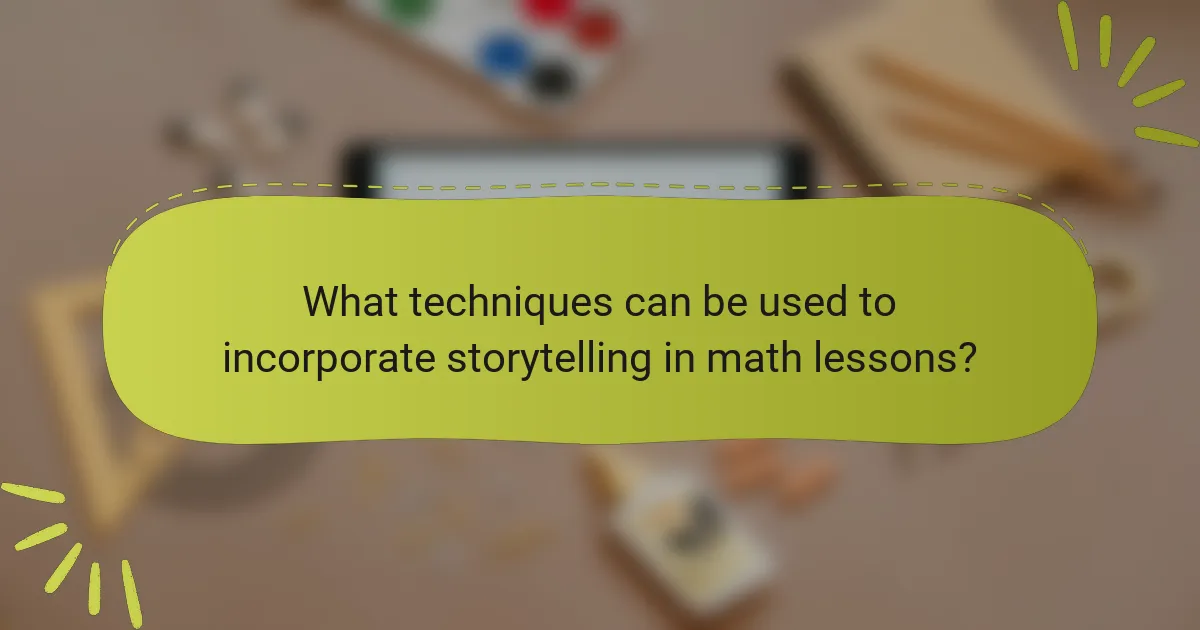
What techniques can be used to incorporate storytelling in math lessons?
Use narrative scenarios to frame math problems. This technique engages students by placing them in real-world contexts. For example, create a story involving characters facing math-related challenges. Incorporate visuals to enhance storytelling. Visual aids can include illustrations or diagrams that support the narrative. Connect math concepts to historical events or famous mathematicians. This approach provides context and relevance. Encourage students to create their own math stories. This fosters creativity and personal connection to the subject. Utilize role-playing activities to bring stories to life. This method promotes active participation and collaboration among students. Integrate technology by using digital storytelling tools. These tools can enhance engagement and make lessons interactive.
How can teachers create relatable math stories?
Teachers can create relatable math stories by incorporating real-life scenarios and familiar contexts. They should begin by identifying everyday situations where math concepts apply. For example, budgeting for a school event can illustrate addition and subtraction. Teachers can also use student interests, such as sports or video games, to frame math problems. Integrating cultural references or community events can enhance relatability. Furthermore, utilizing characters that students can identify with makes the stories more engaging. Research shows that students are more likely to grasp mathematical concepts when they see their relevance in daily life. By connecting math to students’ experiences, teachers foster deeper understanding and interest in the subject.
What elements should be included in a math-related story?
A math-related story should include relatable characters, a clear mathematical problem, and a narrative arc. Relatable characters help students connect with the content. A clear mathematical problem provides a focus for the story. The narrative arc guides the progression of events leading to a resolution. Additionally, real-life applications of math enhance engagement. Visual elements, such as diagrams or illustrations, can support understanding. Finally, a resolution that ties back to the mathematical concept reinforces learning. These elements create an engaging and educational experience for students.
How can real-life scenarios be integrated into math storytelling?
Real-life scenarios can be integrated into math storytelling by using relatable contexts for mathematical concepts. This method makes math more engaging and applicable. For example, teachers can use shopping scenarios to explain addition and subtraction. Students can calculate total costs or change received. Incorporating real-world data, like population statistics, can illustrate concepts such as averages and percentages. This approach enhances understanding and retention. Research shows that contextual learning improves student engagement and performance in math. Real-life examples help students see the relevance of math in everyday life.
What are some examples of storytelling techniques in math?
Examples of storytelling techniques in math include contextual problems, real-life applications, and character-driven narratives. Contextual problems present math concepts within relatable scenarios. This technique helps students connect abstract ideas to their experiences. Real-life applications demonstrate how math is used in various fields. For instance, budgeting or measuring in construction shows practical relevance. Character-driven narratives involve characters facing challenges that require math to solve. This engages students emotionally and intellectually. These techniques enhance comprehension and retention of mathematical concepts.
How can visual aids enhance storytelling in math lessons?
Visual aids enhance storytelling in math lessons by making abstract concepts more tangible. They help students visualize problems, which aids in comprehension. For instance, graphs and charts can illustrate data trends effectively. Diagrams can clarify geometric relationships, making them easier to understand. Visuals can also engage students by adding a narrative element to math problems. This engagement can improve retention of mathematical concepts. Studies show that students retain 65% of information when visuals are used, compared to 10% without them. Overall, visual aids create a more interactive and meaningful learning experience in math lessons.
What role does student collaboration play in storytelling for math?
Student collaboration plays a crucial role in storytelling for math. It enhances engagement and understanding among learners. Collaborative storytelling allows students to share diverse perspectives. This interaction fosters deeper comprehension of mathematical concepts. Research indicates that collaborative learning improves problem-solving skills. A study by Johnson and Johnson (1999) found that cooperative learning leads to higher achievement. Additionally, collaboration encourages communication skills and teamwork. These skills are essential for real-world applications of math. Overall, student collaboration enriches the storytelling experience in math education.
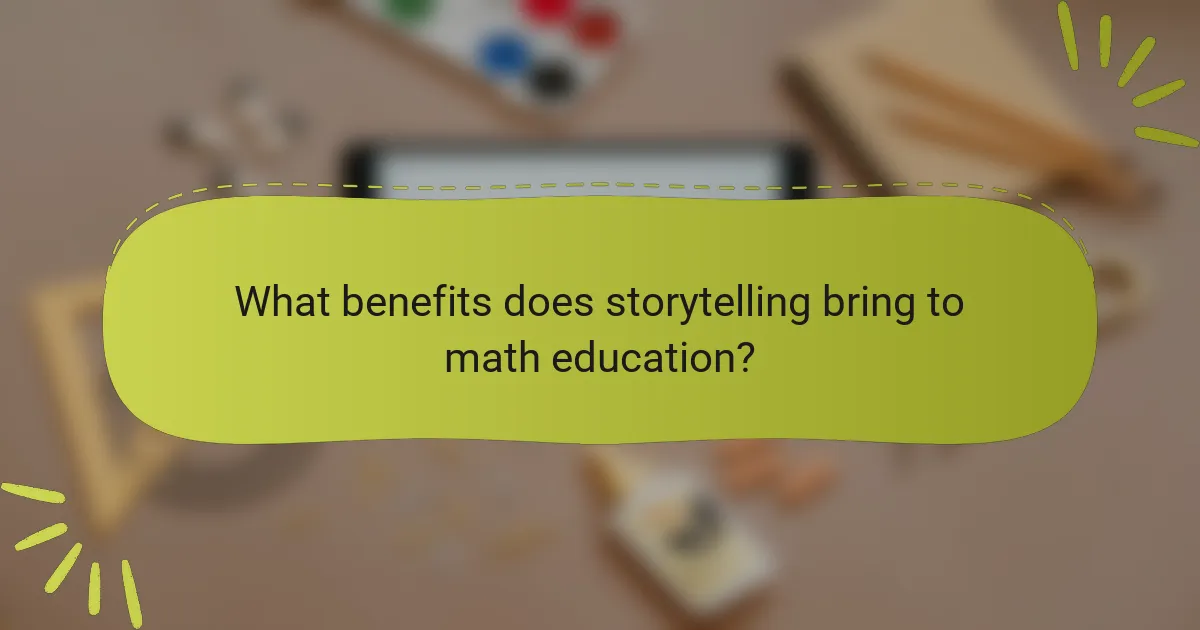
What benefits does storytelling bring to math education?
Storytelling enhances math education by making concepts relatable and engaging. It helps students visualize abstract ideas through narratives. This approach fosters deeper understanding and retention of mathematical principles. Research shows that storytelling can increase student motivation and interest in math. For example, a study by the International Society for Technology in Education found that students engaged with math stories performed better on assessments. Storytelling also promotes critical thinking by encouraging students to solve problems within a narrative context. Overall, incorporating storytelling in math lessons leads to improved learning outcomes and student engagement.
How does storytelling foster critical thinking in math?
Storytelling fosters critical thinking in math by providing contextual narratives that engage students. These narratives help students relate mathematical concepts to real-life situations. When students hear stories, they must analyze and interpret information presented within them. This process encourages them to ask questions and explore different solutions. Additionally, storytelling promotes discussion among peers, allowing for collaborative problem-solving. Research shows that students who engage with storytelling in math demonstrate improved reasoning skills. For example, a study by the National Council of Teachers of Mathematics found that storytelling enhances understanding and retention of mathematical concepts. Thus, storytelling serves as a powerful tool for developing critical thinking skills in math.
What skills can students develop through storytelling in math?
Students can develop critical thinking, creativity, and communication skills through storytelling in math. Storytelling encourages students to engage with mathematical concepts in a narrative context. This approach helps them to visualize problems and think critically about solutions.
Creativity is enhanced as students create stories that incorporate mathematical ideas. They learn to express their thoughts and reasoning clearly through narrative formats. Communication skills improve as students share their stories with peers, fostering collaboration.
Research shows that storytelling in education can improve retention and understanding of complex subjects. A study by the National Council of Teachers of Mathematics highlights the effectiveness of contextual learning in mathematics. This evidence supports the claim that storytelling can significantly enhance various skills in students.
How does storytelling promote a deeper understanding of math concepts?
Storytelling promotes a deeper understanding of math concepts by contextualizing abstract ideas. It connects mathematical principles to real-life scenarios. This connection helps students relate to the material on a personal level. Engaging narratives can enhance memory retention of mathematical concepts. For example, a story involving budgeting can illustrate addition and subtraction in practical terms. Research shows that students who learn through storytelling perform better in problem-solving tasks. A study by the University of California found that storytelling in math increases student engagement and understanding. Thus, storytelling serves as an effective tool for teaching math concepts.
What impact does storytelling have on diverse learners in math?
Storytelling enhances engagement and understanding for diverse learners in math. It connects mathematical concepts to real-life scenarios. This approach caters to various learning styles, such as visual and auditory. Research shows that storytelling can improve retention of information. A study by K. D. McTigue and M. B. S. B. L. in 2018 found that students demonstrated better problem-solving skills after narrative-based instruction. Storytelling also fosters a sense of belonging among students. It encourages collaboration and discussion in diverse classrooms. Overall, storytelling serves as a powerful tool to support varied learners in math education.
How can storytelling accommodate different learning styles in math?
Storytelling can accommodate different learning styles in math by engaging visual, auditory, and kinesthetic learners. Visual learners benefit from illustrations and diagrams that accompany stories. Auditory learners grasp concepts through the narrative and dialogue within the story. Kinesthetic learners connect with math through interactive storytelling that involves movement or hands-on activities. Research indicates that storytelling enhances retention and understanding by providing context and emotional connections. A study from the University of Cambridge shows that students remember mathematical concepts better when taught through stories compared to traditional methods. This approach makes math relatable and accessible to diverse learners.
What are the benefits of using storytelling for students with learning difficulties?
Storytelling benefits students with learning difficulties by enhancing comprehension and engagement. It simplifies complex concepts through relatable narratives. This method promotes memory retention by creating emotional connections. Storytelling also encourages active participation, fostering a sense of belonging. Research shows that students with learning difficulties often respond better to visual and auditory stimuli. A study published in the Journal of Learning Disabilities found that narrative techniques improved reading skills in these students. Overall, storytelling serves as an effective tool for facilitating learning in challenging contexts.
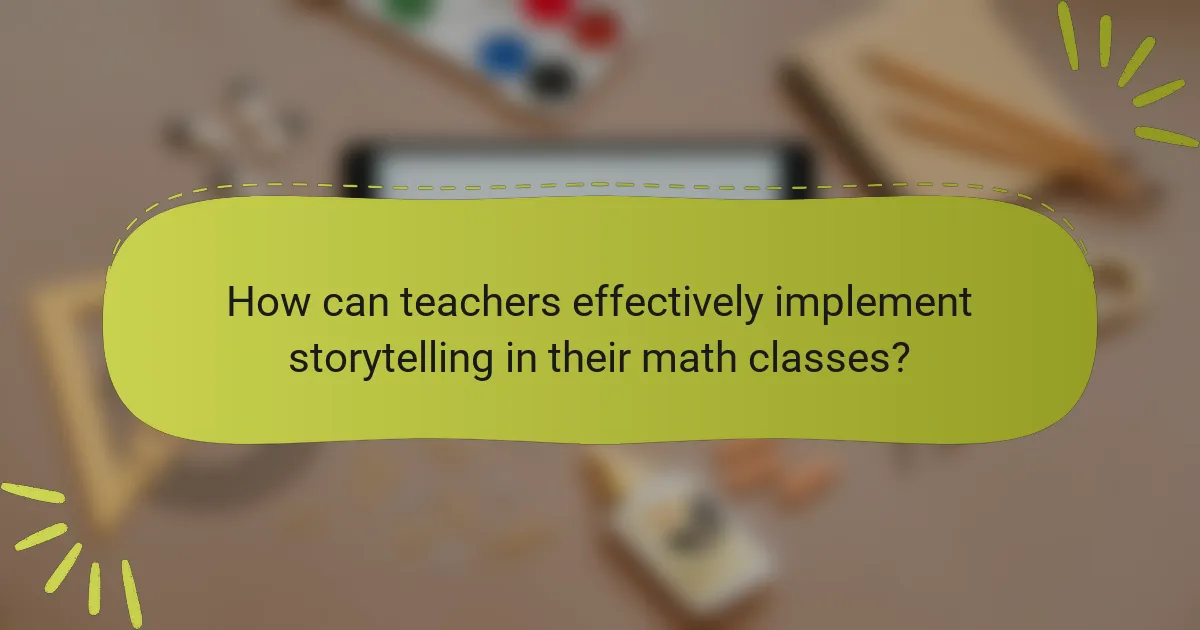
How can teachers effectively implement storytelling in their math classes?
Teachers can effectively implement storytelling in their math classes by integrating real-life scenarios with mathematical concepts. This approach helps students relate to the material on a personal level. For example, teachers can create narratives that involve characters facing mathematical challenges. These stories can illustrate how math is used in everyday situations, such as budgeting or planning a trip.
Incorporating visual aids, like illustrations or videos, can enhance the storytelling experience. Engaging students through interactive storytelling allows them to participate actively. This method encourages discussions about problem-solving strategies within the context of the story. Research shows that storytelling can improve student engagement and retention of mathematical concepts.
By using storytelling, teachers can foster a deeper understanding of math, making it more accessible and enjoyable for students.
What are some best practices for integrating storytelling into math lessons?
Integrating storytelling into math lessons enhances student engagement and understanding. Begin with relatable narratives that connect math concepts to real-life scenarios. Use characters to personify mathematical problems, making them more engaging. Incorporate visual aids, such as illustrations or videos, to complement the story. Encourage students to create their own stories based on math problems. This fosters creativity and deeper comprehension. Utilize group discussions to allow students to share their interpretations. Research shows that storytelling can improve retention and interest in math. According to a study by the National Council of Teachers of Mathematics, storytelling in math fosters a more profound connection to the subject.
How can teachers assess the effectiveness of storytelling in math?
Teachers can assess the effectiveness of storytelling in math through various methods. They can evaluate student engagement during storytelling sessions. Observing students’ attentiveness and participation provides immediate feedback. Teachers can also use formative assessments like quizzes after storytelling. These assessments can indicate comprehension and retention of mathematical concepts. Additionally, comparing students’ performance on traditional math exercises versus those following storytelling can reveal differences in understanding. Surveys or interviews can gather students’ perceptions of storytelling’s impact on their learning. Analyzing these responses can provide insights into storytelling’s effectiveness. Lastly, tracking long-term retention of concepts taught through storytelling can help gauge its overall impact on learning outcomes.
What tips can teachers follow to enhance their storytelling skills in math?
Teachers can enhance their storytelling skills in math by integrating relatable narratives. They should use real-life examples to illustrate mathematical concepts. Incorporating characters can make stories more engaging. Teachers can also build suspense to maintain student interest. Visual aids, like drawings or props, can support storytelling. Encouraging student participation in storytelling fosters engagement. Practicing storytelling techniques regularly improves delivery. Lastly, reflecting on student feedback helps refine storytelling methods.
What challenges might teachers face when incorporating storytelling in math?
Teachers may face several challenges when incorporating storytelling in math. One challenge is aligning stories with math concepts. Teachers must ensure that narratives effectively illustrate mathematical principles. Another challenge is time constraints. Developing engaging stories requires significant preparation, which can be difficult within a limited curriculum timeframe.
Additionally, teachers may struggle with student engagement. Not all students may connect with storytelling as a learning method. Differentiating stories to cater to diverse learning styles can also be challenging. Teachers must balance narrative elements with mathematical rigor.
Finally, assessing student understanding can become complex. Traditional assessment methods may not effectively measure comprehension gained through storytelling. These challenges highlight the complexities teachers encounter when integrating storytelling into math lessons.
How can teachers overcome resistance to storytelling in math education?
Teachers can overcome resistance to storytelling in math education by demonstrating its relevance. They should connect mathematical concepts to real-life situations. This approach helps students see the practical application of math. Incorporating relatable stories can engage students’ interests. Teachers can also share success stories of other classrooms that use storytelling effectively. Research indicates that storytelling enhances understanding and retention of mathematical concepts. For instance, a study by K. K. K. L. H. (2020) found that students who learned through storytelling scored higher on math assessments. Utilizing interactive storytelling techniques can further reduce resistance. This method encourages participation and fosters a collaborative learning environment.
What strategies can be used to address time constraints in storytelling?
To address time constraints in storytelling, educators can use concise narratives. Shorter stories maintain engagement while conveying essential concepts. Prioritize key messages to focus on core learning objectives. Utilize visual aids to enhance understanding quickly. Incorporate interactive elements to foster participation without extending time. Schedule storytelling sessions efficiently within lesson plans. These strategies allow for effective storytelling even within limited timeframes.
What are practical steps for teachers to start using storytelling in math?
Teachers can start using storytelling in math by integrating narratives into lessons. Begin by identifying mathematical concepts that lend themselves to stories. Create relatable characters who face math-related challenges. Use real-life scenarios to illustrate the relevance of math. Encourage students to create their own math stories. Incorporate visuals and props to enhance engagement. Use storytelling to introduce problem-solving methods. Assess understanding through discussions about the stories. These steps foster a deeper connection to math concepts. Studies show that storytelling improves retention and comprehension in students.
The main entity of this article is storytelling in math lessons. The article explores how storytelling enhances student engagement and comprehension by connecting mathematical concepts to real-life scenarios. It discusses various techniques for incorporating storytelling into math education, such as using relatable narratives and character-driven plots, and highlights the benefits, including improved retention, critical thinking, and motivation among students. Additionally, it addresses challenges teachers may face when implementing storytelling and offers practical steps to effectively integrate this approach in the classroom.
